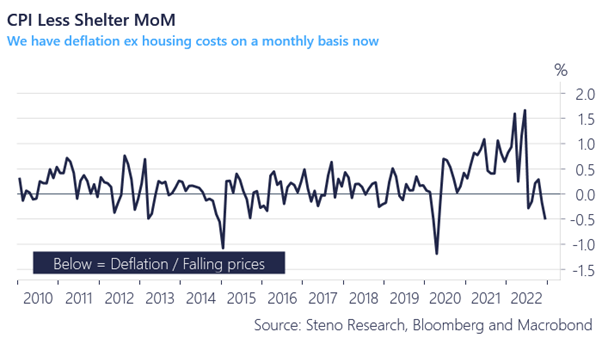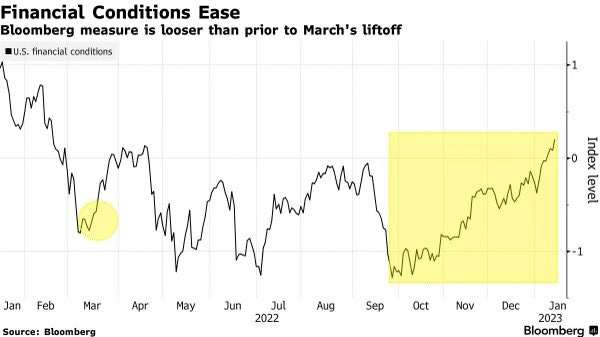Big, Fat, Laggy Indexes.
Happy Monday Morning!
Canadian inflation data drops this week on Wednesday, January 17th. This will be an important headline given that the Bank of Canada is set to meet the following week on January 25th. As of right now the market is still expecting a 25bps rate hike, but that could change if CPI comes in a lot weaker than expected.
As of right now, RBC is calling for headline CPI to fall to 6.4% for December, down from 6.8% in November. That seems about right given the drop we saw last week in the US. Inflation has now fallen for six consecutive months in the US. In fact, if you remove shelter costs (huge lag), you have deflation on a monthly basis.
Of course people will say you can’t remove shelter, it makes up nearly 30% of the CPI basket and people need a place to live! Of course this is true, but we all know the housing market is in the dumps, prices are falling and rents have peaked. Here’s the Zillow rent index against the shelter component of the CPI index.
Shelter inflation is going to drop like a stone, give it time. The Fed knows this and they’re actually working on a new model to better track housing inflation in real time. Researchers at the Bureau of Labour Statistics and Cleveland Fed released a new data series called the New Tenant Repeat Rent Index—a new way of tracking housing inflation.
As of right now, the Consumer Price Index tracks housing inflation through a large panel of housing units that are surveyed every six months. But because rental turnover is slow and CPI tracks contract rents for all units, CPI data lags current market conditions significantly. The New Tenant Repeat Rent Index uses the same micro data that goes into the official Consumer Price Index to select only samples with rental turnover and to assign price shifts to when they happened, not when the units were surveyed.
The New Tenant Repeat Rent Index, therefore, leads official inflation data in the CPI by one year. The All Tenant Repeat Rent Index, which has a similar methodology to the official CPI but assigns price shifts to when they happened not when they were surveyed, leads by one quarter. Here’s the result.
They say housing is a leading indicator for the business cycle, it is also a leading indicator for inflation if your eyes aren’t glued to big, fat, laggy indexes.
Talk to any smart person in the Real Estate industry 18-24 months ago and they were all screaming about rampant inflation. House prices were surging, contractors were in short supply, lumber prices had quadrupled. Everyone was getting rich!
Fed economists later figured out that home price gains over the past two years ultimately kick started a massive wealth effect that was responsible for 39% of the total increase in national, non-shelter CPI!!!
Naturally the Fed is now targeting a reverse wealth-effect by jacking rates and bringing asset prices lower, however, the markets aren’t playing along. Financial conditions are easing with expectations that Central bankers will pivot as inflation falls. A dangerous game, let’s watch.
Canadian Banking Regulator Calls for More Tightening
Sticking with the theme of things that lag, you can add OSFI to the list. The banking regulator is considering adopting new loan to income ratios and a stricter stress test for variable rate mortgages.
The regulator is asking whether banks should be restricted from granting more than, say, 25% of their mortgages (by dollar volume) to borrowers with a loan-to-income ratio of 450% or more.
OSFI also suggests that it may be appropriate to strengthen the affordability test on variable rate mortgages while making longer fixed terms, which "pose less risk," relatively easier to qualify for.
Bold strategy considering the acute weakness in the housing market and the fact that a variable rate mortgage today is already being stress tested at a whopping 8%!! Tightening lending into a credit crunch certainly does not bode well for home prices. Policy makers are supposed to be counter cyclical, but history suggests they are usually the opposite.




